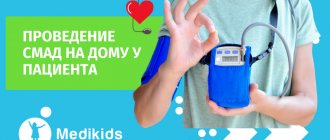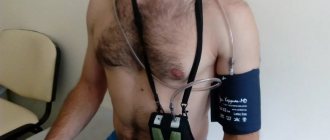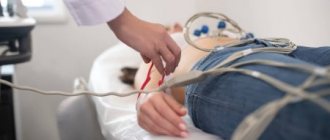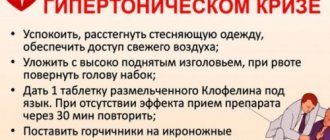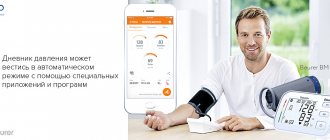24-hour blood pressure (BP) monitoring is a modern research method. Such diagnostics takes into account the daily rhythm of a person’s blood pressure in his or her usual environment. The data obtained together provide a complete picture of the influence of behavioral factors on blood pressure and reflect the dynamics of the influence of antihypertensive drugs in patients receiving therapy for high blood pressure.
How does the device work?
The essence of the procedure is to measure blood pressure at certain intervals. The measurement takes place regardless of the patient’s activities and his wishes - only the doctor sets the time interval. On average, it ranges from 12 to 30 minutes during the day and every hour at night.
During the entire study, the patient fills out a personal diary throughout the day, in which he enters any changes in his state of health and any symptoms that have arisen. By comparing ABPM indicators (24-hour blood pressure monitoring) and diary entries, the attending physician makes an accurate diagnosis. The diary describes the state of activity, rest, and medications the patient is taking. All this data allows us to evaluate pressure drops in a person who is resting or playing sports.
Content:
- How does the device work?
- When is diagnosis prescribed?
- Contraindications to the procedure
- Preparation for the procedure
- Preparation of documents
- Carrying out the procedure
- Preliminary instructions
- Rules for the patient
- What can you learn using ABPM?
- Decoding the results
Blood pressure and activity are two dependent indicators. The basis of the method is the comparison of data that takes into account the patient’s usual activity. In laboratory conditions, the obtained blood pressure readings are unreliable. The procedure lasts for 24-48 hours, depending on the reasons why ABPM was prescribed. A device is fixed on the human body that automatically measures blood pressure.
Indications for blood pressure holter
The method of daily blood pressure monitoring is prescribed in the following cases:
- significant changes in blood pressure levels both during measurements in the doctor’s office and independently;
- high blood pressure values not accompanied by signs of target organ damage - heart, fundus, kidneys, brain;
- blood pressure values are within acceptable limits in the presence of target organ damage (left ventricular hypertrophy, fundus lesions), as well as identification of risk factors for arterial hypertension;
- lack of results from selected antihypertensive drugs;
- episodic hypotension detected in elderly patients, including patients with diabetes mellitus;
- elevated blood pressure during pregnancy, with suspected pre-ellipsia.
ABPM makes it possible to diagnose so-called “white coat” hypertension, as well as masked and persistent hypertension.
White coat hypertension . Quite a common occurrence. Blood pressure levels increase to critical levels only when measured in the doctor’s cabin. Treatment in this case is not carried out, since surges in blood pressure are a physiological reaction of the body.
Masked. In this case, the blood pressure norm is noted exclusively in the doctor’s office. ABPM makes it possible to detect its persistent increase throughout the day.
Sustainable. With this type of hypertension, blood pressure indicators remain consistently elevated, regardless of the location of measurement.
Holter blood pressure is used to predict possible cerebrovascular and coronary complications that develop against the background of hypertension.
Absolute contraindications to ABPM are:
- complications that developed in the previous study;
- damage to the skin in the area where the cuff is applied;
- any bleeding disorders, in particular thrombocytopathy, thrombocytopenia;
- period of exacerbation of blood pathologies;
- vascular damage of the upper extremities;
- hand injury.
Among the disadvantages of the technique, it is worth highlighting the discomfort during night sleep, since measurements are taken around the clock.
When is diagnosis prescribed?
The most common reason for 24-hour blood pressure monitoring is to assess the effectiveness of antihypertensive therapy, especially in the case of combination treatment using several groups of antihypertensive drugs. Other reasons for prescribing ABPM include the diagnosis of early arterial hypertension, symptomatic arterial hypertension, patients with heart failure, with myocardial hypertrophy, in the presence of brain diseases, and suspected sleep apnea syndrome.
ABPM is used to examine patients suffering from various types of hypotension: constitutional and orthostatic.
ABPM allows you to determine the presence of so-called “office hypertension”, in the diagnosis of which it is necessary to promptly establish a work and rest schedule.
Cost of HOLTER AD, HOLTER ECG
| Name of service | Price, rub.) |
| Initial appointment with a cardiologist | 1800 rub. |
| Repeated appointment with a cardiologist | 1300 rub. |
| Prescription of treatment (drawing up an individual treatment regimen) | 1000 - 2500 rub. |
| Taking and interpreting ECG | 1500 rub. |
| HOLTER HELL, HOLTER ECG (staging and interpretation) | 3800 rub. |
| Preparation of medical documents (extracts, certificates) | 900 rub. |
| Registration of a sanatorium and resort card | 2000 rub. |
| Reception of a specialist with issuance of a sick leave certificate | 2500 rub. |
All our services and prices
Contraindications to the procedure
The procedure for 24-hour blood pressure monitoring is a completely safe test and has no absolute contraindications. But there are relative contraindications, which include thrombophlebitis of the upper extremities, acute infectious disease (as a temporary contraindication), impaired motor activity due to the severity of some chronic diseases.
Psychological reasons (phobias and fears) are a contraindication for ABPM.
Holter monitoring may be prescribed if the patient experiences the following symptoms:
- pressing or burning pain behind the sternum and in the region of the heart, with or without irradiation (radiating under the left shoulder blade, into the left arm or not);
- pain in the left half of the chest of a different nature, with a clear connection with or without physical activity;
- characteristic pain in the heart area at night (usually in the early morning) - characteristic of Prinzmetal's angina;
- feeling of lack of air, episodes of severe shortness of breath with a suffocating cough;
- periodic interruptions in the functioning of the heart, a feeling of cardiac arrest;
- frequent dizziness and/or fainting.
Carrying out the procedure
The patient should sit for a few minutes before the procedure. The key to correct diagnosis is the coordination of the actions of the doctor and the patient. The study is carried out:
- with installation of a cuff and tonometer;
- with the obligatory filling out of the diary by the patient;
- with removal of the device;
- with a comparison of the results obtained and the data entered by the patient.
Installing the device takes no more than 15 minutes. The appropriate position for installing the cuff is sitting. The cuff is placed on the right hand of a right-handed person and on the left hand of a left-handed person. It is important to consider which arm the patient has more active. The mark on the cuff should coincide with the most pulsating point on the arm (blood pressure will be measured using it). The point is located on the distal part of the shoulder and is easy to find. Using a special device, the cuff is fixed on the shoulder. A register and a mercury tonometer extend from this device.
Violation of pressure measurement rules
Erroneous results when measuring pressure may not be due to a breakdown of the device, but to a violation of the rules of the procedure. This happens if:
- Take measurements several times in a row without a break (you need to wait 7-10 minutes, and only then measure the pressure again);
- Take measurements immediately after a meal or physical activity, after a cup of coffee or in a state of strong excitement;
- Talk and move, sit cross-legged, strain the arm on which the measurement is being taken;
- Wear the cuff over clothing;
- Incorrect placement of the tube (it should go through the middle of the arm);
- Take an incorrect position, for example, without back support, with your hand above or below heart level, while standing;
- Use the wrong cuff size.
The results can be affected by medications, energy drinks, alcoholic drinks, and even a full bladder.
Preliminary instructions
Blood pressure monitoring will proceed without complications if within two days the patient can meet several mandatory conditions: while measuring blood pressure, the patient must take a comfortable position and, if possible, extend his arm with the cuff. If these recommendations are not followed, you will not be able to obtain accurate results.
Excessive physical activity is not recommended on the day of ABPM. If recording of indicators occurs during work or movement, the patient must stop - this rule guarantees accurate results. If possible, during the period of blood pressure monitoring it is necessary to exclude stressful situations. You should not follow the measurements - such behavior will cause nervousness, which will affect the diagnostic results.
There is no need to worry about the operation of the device at night. As far as possible, the patient does his usual activities - goes to work, does household chores. You cannot limit yourself, otherwise you will not be able to get results in an environment close to the natural environment. If unpleasant symptoms occur, the patient makes notes in a diary indicating the time of day and the load that gave the body a negative reaction.
Indications
Let's consider in what cases it is recommended to perform daily blood pressure monitoring:
- The patient noted an increase in blood pressure;
- It is necessary to adjust the treatment tactics for hypertension - this type of diagnosis allows you to determine the optimal doses of medications;
- The patient has sleep apnea syndrome;
- Sharp fluctuations in blood pressure were noticed;
- The patient experiences fainting and loss of consciousness. In this case, it is recommended to start the diagnosis by monitoring blood pressure in order to identify the true cause;
- Diagnosis is also carried out for preventive purposes, for example, if close relatives have a history of grade 3-4 hypertension;
- The patient has all the symptoms of hypertension, but one-time pressure measurements fail to detect pressure surges. Hypertension may be indicated by such signs as frequent headaches (which do not go away even after taking painkillers), tinnitus, spots before the eyes, etc.
Remember that hypertension can be easily corrected if it is detected promptly and treatment is started in the early stages.
Rules for the patient
Correct measurements depend entirely on the patient's behavior. Keeping a diary is a prerequisite that guarantees diagnostic results. The daily routine is entered into the diary: sleep, exercise, psycho-emotional experiences, walks, clinical symptoms that arise during the day, taking medications. Detailed records will allow you to assess the condition of the body and the factors that worsen the patient’s well-being.
If any negative symptoms appear, the patient consults a doctor. Headaches (severe migraines), weakness or nausea are reasons to suspend ABPM. It is recommended to avoid crowded places and places with a lot of noise for two days - it will affect the recorder and prevent you from taking correct measurements. If the edge of the cuff moves, it needs to be corrected - the correct position of the cuff is 2 cm below the elbow. If the patient is concerned about the correct conduct of ABPM, the attending physician will be able to make an accurate diagnosis and prescribe effective treatment.
Error symbols on the device screen
Device manufacturers have provided the ability to display errors in electronic tonometers on the screen. This allows the user to understand that the device is not working correctly, as well as find out the reason and take the necessary actions.
So, when measuring blood pressure with a Beurer BM 28 tonometer, errors may appear on the screen:
- E 1 indicates the impossibility of measuring pulse;
- E 2 indicates the impossibility of measuring pressure;
- E 3 appears when the cuff does not fit correctly - too loose or, conversely, too tight;
- E 4 indicates the occurrence of errors during the measurement process;
- E 5 is an error that appears when the inflation pressure is more than 300 mmHg;
- E 6 means a system error that requires contacting service.
Error symbols depend on the device model. Thus, on the screen of the Beurer BM 44 tonometer, the indication Er 1 will appear if it was not possible to measure systolic pressure, Er 1 - diastolic. If the readings are not within the intended measurement range, the Hi or Lo icons will appear. The device will indicate that the air has been inflated for too long or its excessive pressure, a malfunction of the system and incorrect position of the cuff. The designation of errors for each device is indicated in the instructions for it.
What can you learn using ABPM?
To diagnose the disease, the variability of blood pressure values during the day is used. The analysis of the results obtained is carried out on the basis of 4 indicators. Average blood pressure readings differ at night and during the day. During the daytime, normal blood pressure is 130 to 85 mm, and at night – 120 to 70 mm.
The second indicator is the recorded moments of maximum increase in blood pressure - the number of deviations from the norm indicates the complexity of the disease. The daily index is calculated, consisting of systolic and diastolic blood pressure. The last indicator that allows you to assess the patient’s health status is the magnitude of the morning increase in blood pressure.
24-hour blood pressure monitoring (ABPM)
Who is indicated for 24-hour blood pressure monitoring?
ABPM
is prescribed in the following cases:
- with a “borderline” increase in blood pressure (when its numbers are not high enough to immediately make a diagnosis, but cause caution in the doctor);
- with the first detected increase in blood pressure;
- if you suspect the symptomatic nature of hypertension (for example, when the increase in pressure is associated with stress before consulting a doctor or occurs due to a concomitant disease);
- when examining young people with unfavorable heredity for hypertension;
- if the patient periodically experiences fainting, to exclude hypotension (low blood pressure);
- in patients with already established hypertension, coronary heart disease and vascular lesions of the brain to identify critical blood pressure values;
- to evaluate and adjust drug therapy.
How is 24-hour blood pressure monitoring performed?
The study is carried out on an outpatient basis: the tonometer cuff is fixed on the patient’s shoulder, as in a normal blood pressure measurement, and the device itself (its weight is no more than 300 g) is attached to the belt, under clothing. After consulting a doctor, you can go home or work. The device will automatically, at certain intervals, measure your blood pressure and record the data obtained. ABPM does not interfere with leading a normal lifestyle: eating, sleeping and even playing sports. Your doctor will likely ask you to keep a diary to record episodes of physical activity (climbing stairs, lifting heavy objects), periods of rest, sleep, waking up at night, and symptoms of discomfort, such as heart pain or dizziness, if you experience them. ABPM is most often carried out with blood pressure recording at intervals of 15 minutes during the day and 30 minutes at night. The absence of a nocturnal decrease in blood pressure or its excessive decrease should attract the attention of the physician, since instability of blood pressure and episodes of hypotension increase the risk of target organ damage. After 24 or 48 hours (depending on the recommended duration of the study), you will need to turn off the device and come back for a consultation with a cardiologist. He will decipher the data received, comparing it with the information in your diary, and make a conclusion about the state of your health.
Is it possible to sign up for ABPM without a doctor’s referral?
You can take ABPM on your own initiative if you think this study will benefit you.
Even if the procedure does not reveal any abnormalities, be sure to save the results of the study - they can be used as a sample for comparison at subsequent ABPM.
What can and cannot be done during ABPM?
There are simple recommendations for patients undergoing daily blood pressure monitoring:
- Watch the position of the cuff on your shoulder. Its lower edge should be fixed 1-2 fingers above the elbow. If you feel that the cuff has slipped off your arm, be sure to adjust it.
- Before each measurement, the ABPM device beeps. If you have the opportunity, do not move while measuring pressure, so the results will be more accurate. While the device pumps air into the cuff, relax your hand. At the end of the measurement, a repeat beep will sound.
- Make sure that the tube connecting the monitor to the cuff is not pinched by clothing or when you are sitting or lying down.
- Do not allow water to come into contact with the device (do not take a shower during the study), and also try to avoid prolonged stay near sources of electromagnetic radiation (power lines, microwave ovens, television and radio transmitters) during ABPM.
- If you think that the ABPM device is out of order, do not try to fix it yourself and do not disassemble it. Report the incident to your healthcare provider.
What can a doctor learn from ABPM results?
In addition to the direct increase in blood pressure in various situations, the cardiologist examines a person’s circadian rhythms - the natural decrease or increase in blood pressure during the day. Deviations from the normal rhythm may be a harbinger of hypertension or other health problems. Based on the information received, the doctor may recommend that you change your diet, give up bad habits, or undergo additional examinations.
During 24-hour blood pressure monitoring, the following indicators are assessed:
- Average blood pressure values during the study period. The normal value of average blood pressure per day is less than 130/80 mm (less than 135/85 mm during the day, less than 120/70 mm at night).
- Episodes of maximum increase in blood pressure.
- Daily profile (daily index) of systolic and diastolic blood pressure.
- The magnitude and speed of the morning increase in blood pressure.
Decoding the results of 24-hour Holter monitoring
What will the patient read in the received research protocol? In addition to the given electrocardiograms and their brief descriptions, a conclusion is printed in the form, which indicates the following parameters:
type of monitoring – ECG, blood pressure, or both
- the total number of heart rate (HR) reaches about hundreds of thousands or more per day
- sinus or non-sinus (with atrial fibrillation, atrial flutter, for example) rhythm
- maximum and minimum heart rate per day
- average daily heart rate and its type (tachy-, normo- or bradysystole, which means rapid, normal or rare heartbeat, respectively)
- heart rate characteristics - response to stress (normally it should be adequate - an increase within acceptable values), a decrease in heart rate at night, whether submaximal heart rate has been achieved or not (75% of the maximum, achieving it means good tolerance to physical exercise, failure to achieve it indicates the occurrence of ischemia at light loads)
- level of exercise tolerance – high, medium or low
- rhythm disturbances are described if they are detected, for example, ventricular or supraventricular extrasystoles, single, paired or group, tachycardia runs are indicated, if any
- changes in the blood supply to the myocardium are described, for example, disturbances in repolarization processes, or episodes of elevation or depression (decrease) of the ST segment - signs of myocardial ischemia, at what time they occur and whether they are associated with load, whether they were accompanied by pain, shortness of breath or other subjective signs.


